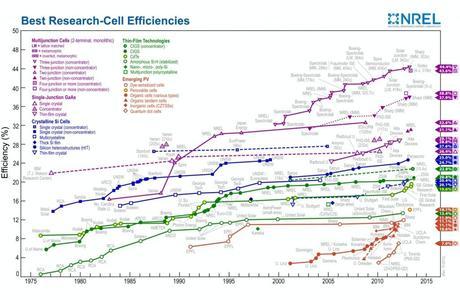 Solar panels on the roof of the AEON LakeTown shopping mall in Saitama, Japan. (Credit: Flickr @ Toshihiro Oimatsu http://www.flickr.com/photos/oimax/)
Solar panels on the roof of the AEON LakeTown shopping mall in Saitama, Japan. (Credit: Flickr @ Toshihiro Oimatsu http://www.flickr.com/photos/oimax/)A recent study by MIT and Santa Fe Institute researchers found a “dramatic growth in innovation” in renewable energy technologies, primarily in solar and wind energy. A lot of this research is dedicated to improving the efficiency of solar cells. More efficient solar cells naturally mean more efficient solar panels, ones that can effectively compete with fossil fuels in terms of cost effectiveness. A number of new solar cell efficiency records has been set just recently.
Solar cell efficiency is the ratio of the electrical output of a solar cell to the incident energy in the form of sunlight. By convention, solar cell efficiencies are measured under standard test conditions (STC) unless stated otherwise. STC specifies a temperature of 25 °C (77 °F) and an irradiance of 1000 W/m2. Under these test conditions a solar cell of 20% efficiency with a 100 cm2 (approx. 0.108 ft2) surface area would produce 2 watts of power.
Speaking of solar cell efficiency it is important to remember two more things. First, there are a lot of different types of solar cells that vary greatly in cost, complexity, mechanical properties and other parameters. Therefore, it would be meaningful to compare the efficiency of the solar cells only if they are of similar design. Otherwise, parameters like price per kilowatt or applicability for a specific purpose should be considered in the first place. Second, there is a gap between the research and the commercial solar cells. A research cell may be very efficient but difficult or even impossible to produce on a large scale.
The image below provides an overview of the efficiency records for different solar cell types, including some emerging technologies like quantum dots, dye-sensitized cells and perovskite structures that are not very efficient yet, but show a great promise. In a Nature publication in June 2013, scientists from the Swiss Federal Institute of Technology in Lausanne reported the development of a state solid version of the dye-sensitized solar cell containing perovskite compound that is fabricated by a new two-step process raising their efficiency up to a record 15% without sacrificing stability.

Conversion efficiencies of best research solar cells worldwide from 1976 through 2013 for various solar cell technologies. Efficiencies determined by certified agencies/laboratories. (Credit: National Renewable Energy Laboratory (NREL), Golden, CO.)
Multi-junction solar cells are naturally the most efficient ones. As the name suggests, these cells have several “p-n junctions”—elementary “building blocks” that convert light to electricity. Each block is tuned to a different wavelength of light, reducing one of the largest inherent sources of losses, and thereby increasing efficiency. This comes at a price of significantly increased complexity, and, therefore, much higher manufacturing costs.
The world record for four-junction solar cell efficiency (44.7%) was achieved this September by the Fraunhofer Institute for Solar Energy Systems ISE, Germany. Back in May 2013, the German-French team of Fraunhofer ISE, Soitec, CEA-Leti and the Helmholtz Center Berlin had already announced a solar cell with 43.6% efficiency. In June, Sharp Corporation has achieved the world’s highest solar cell conversion efficiency of 44.4%, using a concentrator triple-junction compound solar cell. The world record of 31.1% conversion efficiency for a two-junction solar cell is currently held by the Energy Department’s National Renewable Energy Lab.
As for commercial solar cells, it would be impossible to list all the records. Among the most prominent is the 16.1 percent total area module conversion efficiency record, achieved by First Solar, Inc., an American manufacturer of thin film photovoltaic modules this April. This record came just six weeks after First Solar announced a new world record for CdTe solar cell efficiency of 18.7 percent.
Since then GE has beaten First Solar’s record with an experimental CdTe solar cell that achieved 19.6% conversion efficiency. However, GE has decided to cancel plans to ramp its own cadmium telluride (CdTe) thin-film operations in Aurora, Colorado, instead selling the intellectual property portfolio to CdTe leader, First Solar.
But the most widespread type of commercial solar cells is still silicon-based solar cells, either single crystal or multicrystalline. Multicrystalline silicon is easier to mass-produce and is therefore cheaper. However, the material quality of multicrystalline material is lower because of the presence of grain boundaries. Single crystal solar cells are more expensive to make, and more efficient.
A Solar Holdings Co. (China), one of the world’s largest solar cell producers, announced this August that its p-type mono-crystalline silicon (“mono-Si”) solar cells have surpassed 20% conversion efficiency. This claim was independently confirmed and certified by the Fraunhofer ISE’s photovoltaic calibration laboratory. Just a couple of weeks prior to that, the company has achieved an industry-leading conversion efficiency of 18.3% with their multi-crystalline silicon solar cells. While less impressive than most of the records cited above, this one was set with a mass-produced and a relatively inexpensive product.
John Davenport

